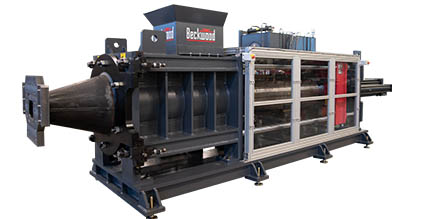
As the demand for stronger, lighter composite materials increases, manufacturers are looking for new ways to create large parts that have traditionally been formed using metal dies, stampings, or welded assemblies. Such is the case when a manufacturer of composite railroad ties explained their unique injection molding process to Beckwood’s application engineers.
The resulting side-acting extrusion press features a gravity-feed system which allows the material to gravity-drop directly into the pressing chamber. A spherical “plunger” attached to the press cylinder rod compacts and extrudes the material through the heated nose cone into a mold positioned on the outfeed side of the machine, and a mold latching system around the nose cone ensures that the mold is flush to the surface of the nose cone in order to reduce potential material waste. This out-of-the-box design has been successful in revolutionizing the way manufacturers processes their raw material into a finished product.
Consult a Beckwood Engineer about your press needs

